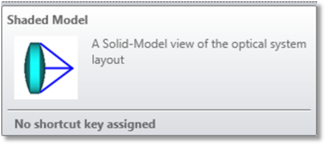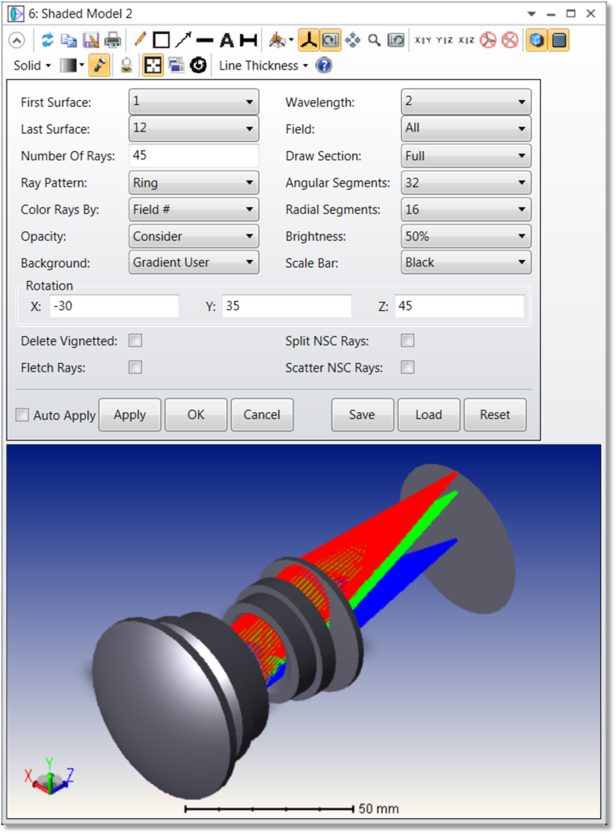Shaded Model


Draws a shaded solid representation of the lens.

When rendering NSC detector objects with more than 1,200,000 pixels will not show individual data for each pixel to keep the total amount of required computer memory reasonable.
See "Toolbar button functions" for more information on the Shaded Model toolbar.
First Surface The first surface to be drawn.
Last Surface The last surface to be drawn.
Wavelength Either any one or all wavelengths may be shown.
Field Either any one or all field positions may be shown.
Number of Rays The number of rays specifies the number of rays to be drawn for each selected field and wavelength. The rays will be evenly distributed along the fan of the pupil, or around the perimeter if Ring is the selected Ray Pattern, or unless apodization has been specified. This parameter may be set to zero. It is ignored if the Ray Pattern is set to List.
Draw Section Select "Full" to draw each lens element completely. The 3/4, 1/2, and 1/4 options draw just that much of the element, yielding a cut away perspective of the lens interior. This only affects sequential surface data, and not NSC objects.
Ray Pattern Choose XY Fan, X Fan, Y Fan, Ring, List, Random, or Grid to indicate what the pattern of rays to be traced should be. The List option indicates that the rays to be traced are user defined and listed in a file; see the discussion below for information on the ray list format. If List is selected the Number of Rays setting is ignored.
Scale Bar The Scale Bar can be set to Black, White or Off. The scale bar will be automatically adjusted when the Shaded Model is zoomed in or out.
Angular Segments The number of angular segments used to approximate the lens shapes. Larger numbers require more processing time.
Radial Segments The number of radial segments used to approximate the lens shapes. Larger numbers require more processing time.
Rotation About X The angle in degrees by which the lens appears to be rotated about the X axis.
Rotation About Y The angle in degrees by which the lens appears to be rotated about the Y axis.
Rotation About Z The angle in degrees by which the lens appears to be rotated about the Z axis.
Color Rays By For sequential rays, "Field #" will use color to distinguish between each field position, "Wave #" to distinguish between each wavelength, "Config #" to distinguish between configurations, and "Wavelength" to approximate the color of wavelengths in the visible spectrum.
For non-sequential rays "Field #" will use color to distinguish between each source number, unless a source has a user defined color assigned to that source.
Background Selects the background color.
Opacity The options are ignore, which ignores the opacity values and draws all surfaces and objects as opaque; consider, which draws partially transparent surfaces and objects based on settings in the surface and object properties settings dialog boxes; or All 50%, which overrides the defined opacity and uses 50% for all objects.
Brightness This control varies the overall brightness of the image.
Delete Vignetted If checked, rays are not drawn if they will be vignetted by any surface.
Configuration This option is activated when more than one configuration is used. Select "All" to show all configurations, "Current" to show just the active configuration, or select any combination of other configurations.
Offset X, Y, Z This option is activated when more than one configuration is used. The X, Y, and Z direction offset between configurations in lens units. Only has an effect on the drawing if "All" configurations are being drawn.
Fletch Rays If checked, small arrows are drawn on each ray to indicate the direction of propagation.
Split NSC Rays If checked, rays from NSC sources will be statistically split at ray-surface intercepts. Rays entering from the entry port are not affected by this setting.
Scatter NSC Rays If checked, rays from NSC sources will be statistically scattered at ray-surface intercepts. Rays entering from the entry port are not affected by this setting.
Next:


